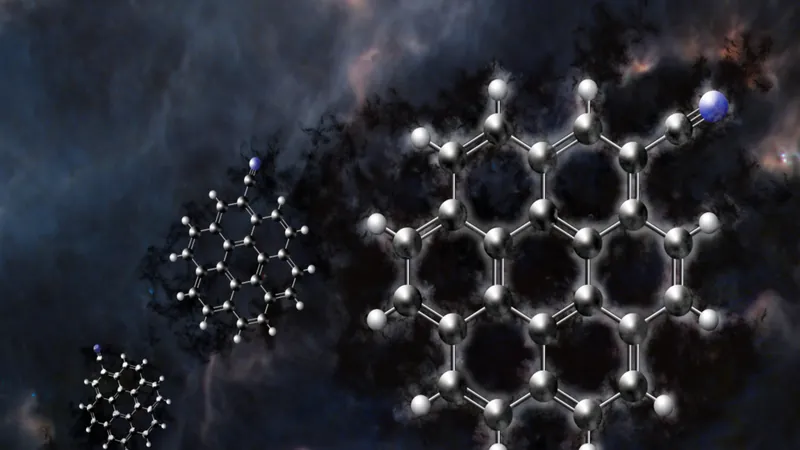
Cosmic Chemistry Breakthrough: Life's Building Blocks Discovered Before Stars Even Form!
2025-06-30
Author: Jia
A Groundbreaking Cosmic Discovery
Astronomers are buzzing with excitement after a monumental discovery in deep space. They've unveiled a substantial "aromatic" molecule, providing new insights into the very foundations of life in the universe. This finding could mean that essential ingredients for life are created in planetary systems long before stars even ignite.
What is Cyanocoronene?
Meet cyanocoronene, a remarkable member of the polycyclic aromatic hydrocarbons (PAHs) family. These carbon-based organic compounds consist of several interconnected aromatic rings, making them chemically stable and capable of harboring a significant portion of the universe's carbon.
The National Radio Astronomy Observatory (NRAO) highlights the importance of PAHs in cosmic chemistry, stating that they might be fundamental in forming stars and planets. Previously, only smaller PAHs were detected in the cosmos, but this latest discovery pushes the boundaries of our knowledge.
The Recipe for Life in Space
Astounding research reveals that cyanocoronene can form in the frigid depths of space through reactions between coronene and reactive cyanide radicals, even before the birth of a star. This points to the possibility of complex organic chemistry occurring in the early stages of star and planet formation—an exciting notion for astrobiologists.
The Power of the Green Bank Telescope
Identified using the Green Bank Telescope (GBT) in the Taurus Molecular Cloud (TMC-1), cyanocoronene's presence was confirmed with extraordinary precision. The GBT, the world's largest steerable radio telescope, is a vital asset for capturing faint radio signals from the universe, providing clarity beyond optical telescopes that only capture visible light.
In TMC-1, a well-known star-forming region, the GBT detected unique spectral lines that matched the characteristics of cyanocoronene, demonstrating the molecule's significant presence in this rich chemical environment.
Unlocking the Secrets of Space Chemistry
Each new discovery in this realm tantalizes scientists with the potential to uncover even larger PAHs and explore how these compounds evolve, fragment, and interact under cosmic conditions like ultraviolet light and cosmic ray shocks.
Gabi Wenzel of MIT, the study's lead author, expressed the excitement: "Every new detection brings us closer to understanding the origins of complex organic chemistry in the universe—and potentially, the building blocks of life itself."
Looking Ahead
This groundbreaking research was recently showcased at the 246th meeting of the American Astronomical Society in Anchorage, Alaska, marking a pivotal moment in our quest to understand the cosmos and our place within it.





 Brasil (PT)
Brasil (PT)
 Canada (EN)
Canada (EN)
 Chile (ES)
Chile (ES)
 Česko (CS)
Česko (CS)
 대한민국 (KO)
대한민국 (KO)
 España (ES)
España (ES)
 France (FR)
France (FR)
 Hong Kong (EN)
Hong Kong (EN)
 Italia (IT)
Italia (IT)
 日本 (JA)
日本 (JA)
 Magyarország (HU)
Magyarország (HU)
 Norge (NO)
Norge (NO)
 Polska (PL)
Polska (PL)
 Schweiz (DE)
Schweiz (DE)
 Singapore (EN)
Singapore (EN)
 Sverige (SV)
Sverige (SV)
 Suomi (FI)
Suomi (FI)
 Türkiye (TR)
Türkiye (TR)
 الإمارات العربية المتحدة (AR)
الإمارات العربية المتحدة (AR)